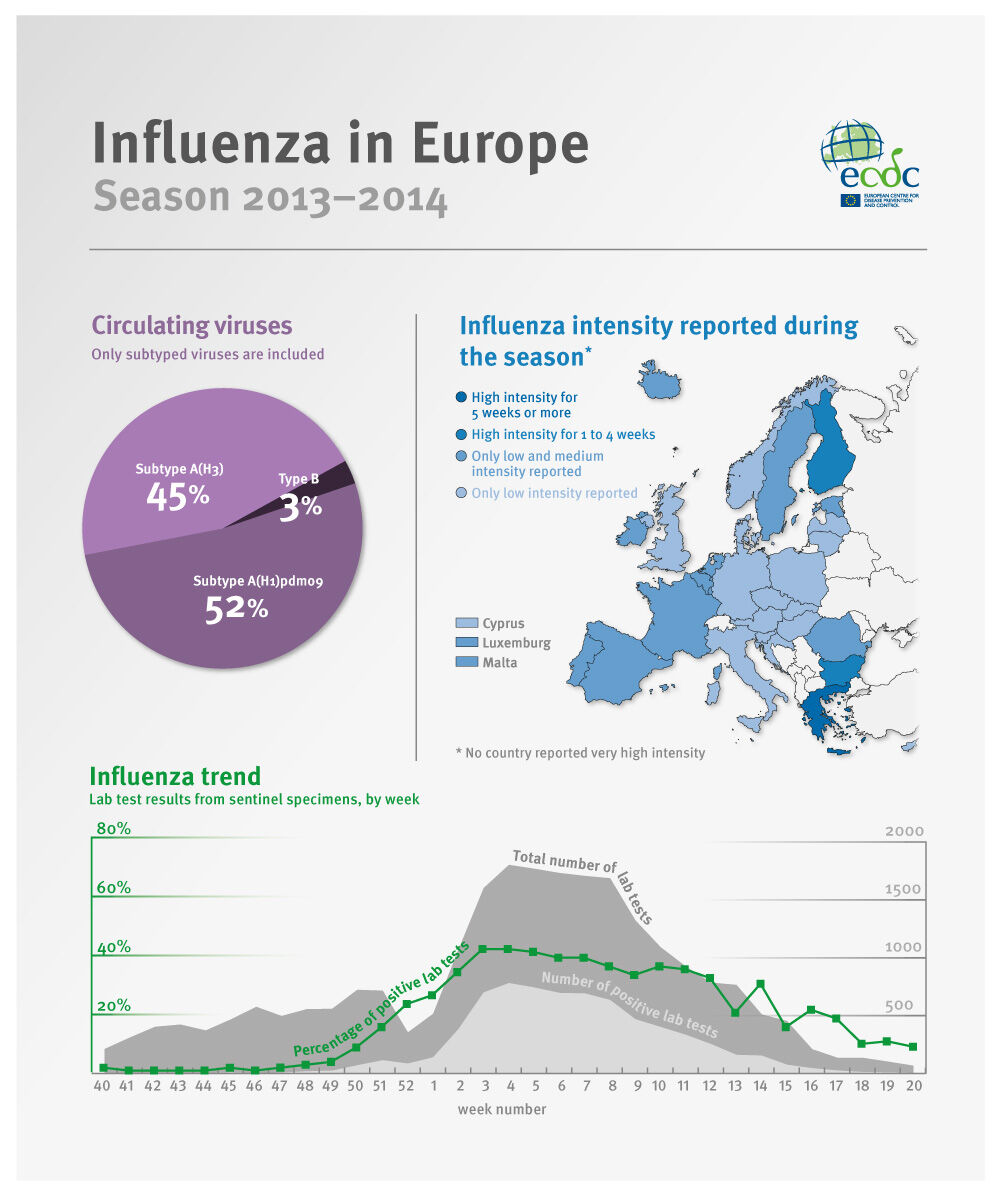Summary of the influenza 2013–2014 season in Europe
Active circulation of influenza has started late in Europe in the 2013-2014 season, with a different timing across EU/EEA countries, states the annual ECDC risk assessment on seasonal influenza. The first countries affected have been Bulgaria, Greece, Portugal and Spain, where the A(H1)pdm09 influenza virus has dominated. Without any specific geographic pattern, influenza activity has since spread rapidly across Europe. In Bulgaria, Portugal and Spain, the season peaked in weeks 4 and 5/2014, while influenza activity still continues to increase in Greece.

Download

Influenza in Europe, summary of the season 2013–14
Active circulation of influenza has started late in Europe in the 2013-2014 season, with a different timing across EU/EEA countries, states the annual ECDC risk assessment on seasonal influenza. The first countries affected have been Bulgaria, Greece, Portugal and Spain, where the A(H1)pdm09 influenza virus has dominated. Without any specific geographic pattern, influenza activity has since spread rapidly across Europe. In Bulgaria, Portugal and Spain, the season peaked in weeks 4 and 5/2014, while influenza activity still continues to increase in Greece.
Circulating virus types
In week 07/2014, circulating A(H1)pdm09 virus was dominant or co-dominant in 21 reporting countries while A(H3) was dominant in four countries. In contrast to the season in the US with an overwhelming dominance of A(H1)pdm09 virus and substantial numbers of severe cases, A(H1)pdm09 virus is not as dominant in EU/EEA countries. This may be due to differences in prior exposure to A(H1)pdm09 virus or higher vaccination coverage among the age groups most likely to transmit the disease.
Vaccine effectiveness
Data on viruses circulating so far indicate a good match with the current influenza vaccine. North American studies estimate high to moderate vaccine effectiveness, while a mid-season study from one Spanish region, Navarre, suggests lower effectiveness. This warrants further studies to understand the discrepancies. Vaccination of high-risk groups and healthcare workers, in accordance with national guidelines, in countries that are still at an early stage in their influenza season remains the most effective way of reducing serious outcomes and transmission of the disease.
Risk assessment for the remaining season
- In countries with A(H1)pdm09 circulating, especially in countries where influenza activity has already peaked, a later circulation of A(H3) virus is possible. In the event of A(H3) virus circulation, some severe cases are likely, most probably in people older than those typically infected by A(H1)pdm09 virus.
- In countries currently with no/low influenza activity, the dominant influenza virus strain and the intensity are unpredictable, but are likely to be similar to that observed in countries that have already passed their intensity peak (Bulgaria, Portugal and Spain). However, differences in vaccination coverage and natural immunity may influence both intensity and the number of severe cases.
- In the few countries where A(H3) virus has been dominant so far, a second wave or a co-circulation of A(H1)pdm09 virus is possible.
Background
ECDC has produced an annual risk assessment of the seasonal influenza epidemics in Europe since the 2010/11 season following the model developed during the 2009 pandemic. The main objectives of this risk assessment are:
- to provide an early description of the epidemiological pattern of seasonal influenza;
- to predict the evolution of influenza activity for the rest of the season;
- to identify affected populations and the impact on primary and secondary healthcare services;
- to assess influenza vaccine effectiveness and susceptibility to antiviral drugs;
- to suggest scientific and public health advice on measures to be taken to reduce the burden of seasonal influenza.







